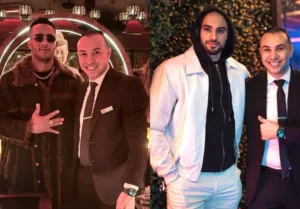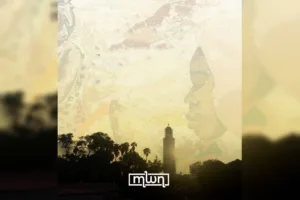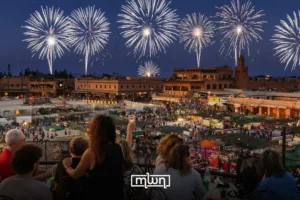Rabat – “My profession is butcher,” said Sadik. Sadik didn’t really need any introduction, since he had just slaughtered a ram on the terrace of an apartment in Rabat’s medina. After this greeting, he removed his blood-stained white overcoat and returned his long knives to his red snakeskin briefcase.
On Eid al-Adha, celebrated in Morocco this year on June 17, the majority of shops were closed as families gathered to celebrate. Only the butchers were open for business. The narrow streets of the medina – the only part of the city that dates back to colonial times – were empty except for teenagers blowtorching ram heads at every street corner, and sanitation workers sweeping the cobblestones of offal and excrement.
To those experiencing the feast of sacrifice for the first time, Eid al-Adha can be an overwhelming experience.
According to the Islamic tradition, prophet Ibrahim had a dream in which God commanded him to demonstrate his devotion by sacrificing his son, Ishmael. When Ibrahim was about to make the sacrifice, a messenger from God appeared and rewarded Ibrahim’s fealty by offering him a ram to sacrifice in place of his son. Families gather each year on Eid to celebrate this act of mercy by sacrificing their own ram.
Eid al-Adha also marks the end of the Hajj, or the period of annual pilgrimage to Mecca.
A Traditional Eid In Rabat’s Medina
Riads, traditional multi-generational houses arranged around a central courtyard, were once the dominant form of accommodation in the medina. However, the Wedani family, like many others today, prefer to live separately in nuclear-family units. Consequently, many traditional riads have been divided into individual apartments and the Werdani family lives between two of these small apartments, separated by a 5 minute walk through the Medina’s maze-like streets.
On the morning of Eid, the Werdani family gathered for breakfast at their third floor apartment on Sidi El Aidi street in the southwest corner of the old city. The apartment was a hive of activity as women prepared salads and potatoes and men came in and out from the mosque and the market. Just outside the door to the apartment on the rooftop terrace, a ram with curling horns was tied by blue twine around its neck to a metal hook on the wall.

Souika Street in Rabat Medina, deserted on the morning of Eid al-Adha as businesses are closed to celebrate the holiday.
Before breakfast was over, Sadik arrived from the butchers shop, carrying only his snakeskin briefcase of utensils. Pleasantries were exchanged and the men present, some as young as 15, joined to hold the sheep on its back as Sadik delivered the decisive cut to the neck. The animal struggled for a minute as blood spurted from the wound, painting most of those present and the epoxy floor burgundy. The animal was promptly gutted and skinned and its carcass was hung from the hook on the wall by its achilles tendons, blood still dripping from the severed neck.
Contemporary Variations On The Traditional Eid Celebration
Staying true to this religious practice has become more expensive in recent years, with the costs associated with purchasing a ram increasing every year. In 2024, a prize ram – a larger animal with impressive horns – could cost as much as MAD 7,000, approximately USD 700.
For some, the costs associated with purchasing a ram have become prohibitively expensive, with an increasing number of families relying on donations to celebrate Eid. It’s custom that one third of each ram slaughtered should be given as a donation to the poor who cannot afford to purchase their own.
For an increasing number of upper-middle class moroccans, rising prices reflect a different kind of opportunity. ‘Eid vacations’ and ‘Eid staycations’ have become popular amongst those who would rather spend upwards of MAD 5,000, or USD 500, on a luxury experience with their nuclear family. The Fairmont La Marina Rabat-Salé – a commanding hotel which overlooks the mouth of the Oued Bou Regreg – advertised an “Iconic Aid Staycation” for a more contemporary celebration, with communal feasts that “evoke your joyful childhood barbecues” from the comfort of five-star accommodation.
There is also a growing number of Moroccans who cannot eat meat for health reasons, or who have become disillusioned with the ritual aspects of slaughter. For this group, the festival presents a chance to reach across class and income boundaries and celebrate the shared faith that permeates Moroccan society.
Touria Cherif D’Ouezzan, living alone and with no appetite for meat, purchased a small ram for Eid al-Adha a few years ago and took it to a shelter for the elderly in Kenitra. The residents were so delighted to participate in the ritual, which they had gone without for a number of years, that they fastidiously took to cleaning and butchering the meat.
Although she could not eat the meat, Touria stayed to share the feast with the residents because she wanted to create a sense of community with the residents, rather than make them feel like the object of her charity. She has continued the trend ever since, with several of her family and friends adopting a similar tradition. With this new routine, Touria and others honor the festival’s values of compassion and community, transcending income and class divides to embrace the spirit of Eid al-Adha.
















